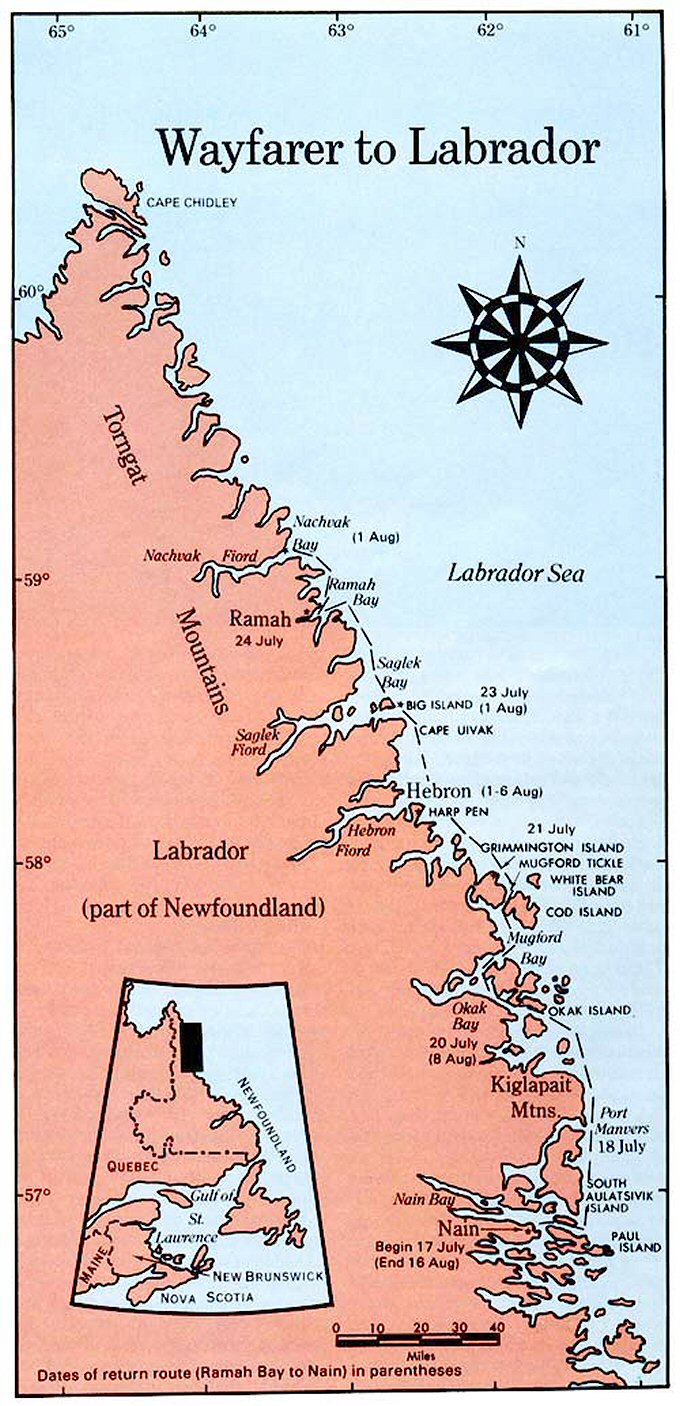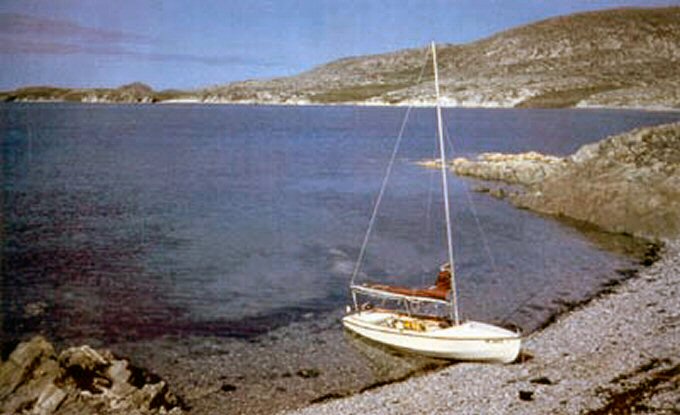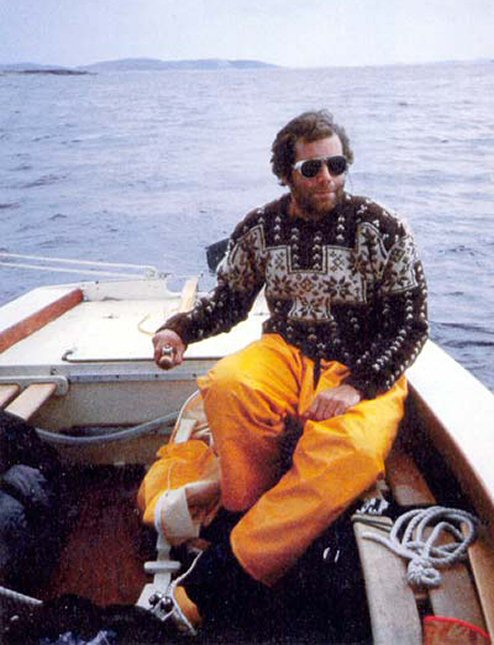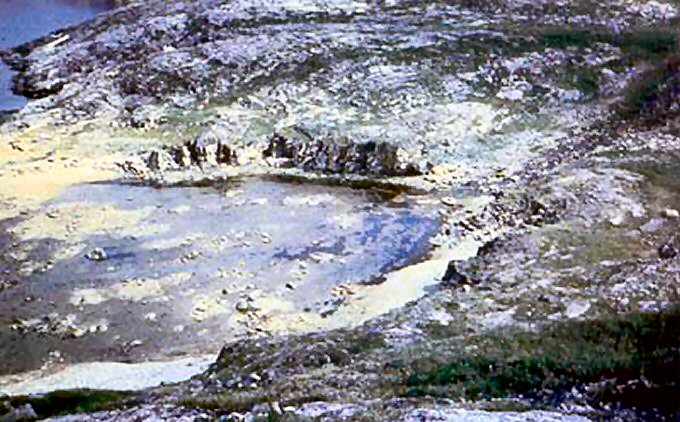| Wayfarer to Labrador Challenging the Far North in an Open Dinghy by Geoffrey Heath photographs by the author Small Boat Journal #44 Sept. 1985 .. |
|
Mugford Tickle. A funny name
for a narrow foreboding channel walled on both sides by the sheer
cliffs of two deserted islands on the coast of Labrador. There is no
refuge here, no protection from the tidal current of the steel-colored
sea, sprinkled thick with chunks of ice. Even now, the water
temperature is about 36 degrees, not a place for a casual swim. Mugford
Tickle would seem an awesome place from the deck of the Queen Mary.
Looking up at the cliffs from a 16-foot open sailboat, the place hovers
at the edge of terrifying.
If there had been a way, I
would have bypassed it, just as I would have had a companion with me if
luck hadn't run the other way. But I had decided to sail, and changes
of plans and illness had left me with the choice of either a solo trip
north along the coast of Labrador, or none at all. So there I was,
alone in my Wayfarer dinghy, Wayward
Drummer, with Mugford Tickle ahead of me. It was like sailing
straight into the Grand Canyon. Wind does funny, unpredictable things
around cliffs. I had been running with a 15-knot breeze dead on my
stern when suddenly, with no warning, the wind was blowing 15 knots
smack on the nose.
Since my Wayfarer is an unballasted centerboarder and relies on crew weight for stability, sudden shifts of wind can capsize it. Wayward Drummer has only tipped over twice, both times at the base of cliffs, where a slight hesitation in tending the sheet and tiller brought instant trouble. One capsizing took place in Somes Sound, at home in Maine. The other was on the east coast of Newfoundland, where Misha Kirk and I were killing time waiting for the freighter that would carry us and Wayward Drummer north to Nain, Labrador, its northernmost stop. Kirk and I had decided to get in some sailing practice, and close under a cliff with the mainsheet cleated down, we soon got our introduction to the frigid waters of the Far North. By the time we had righted the boat and emptied the bilges with a bucket we were wiser and meeker men.  Trip Takes Shape As we first planned it, my
friend Dave Getchell, Sr. and I were going to extend a trip we had
taken north along the Labrador coast in an 18-foot aluminum motor boat
(SBJ#17). On our second trip, we hoped to travel farther north, to
Ramah Bay, where aerial photographs showed an impressive range of
mountains and glaciers. The only topographical map of the region was
practically blank, a strong appeal to our spirit of exploration. We
planned a combined boating/mountaineering venture. However, fuel is not
available north of Nain, 200 miles short of Ramah Bay, and hammering
along under power lacked the sense of adventure we were seeking.
A sailboat seemed the most
practical solution. The 1980 trip confirmed our belief that a small,
shallow-draft boat made the most sense along the Labrador coast.
Anchoring off in deep-water fjords under storm conditions is far more
dangerous than beaching a boat and camping on shore. Also, the coast is
only sketchily charted, and the inshore waters are sprinkled with
"sunkers," the local term for rock ledges. Offshore only a few miles
you run into "iceberg alley," with all the navigational unpleasantness
the name implies. Frequent groundings, or even occasional brushes with
the pack ice, were experiences we could do without.
Speed as well as seaworthiness
were prerequisites in our new boat. Many of the headlands that we would
have to round offer no shelter for many miles. The swifter the boat,
the less time we would be exposed. The traditional dory and whaleboat
were ruled out as a result. The boat had to be able to ride on a
trailer behind my Datsun pickup, and it had to be reasonably cheap.
Both Dave and I had read Frank Dye's book, Ocean Crossing Wayfarer, which
recounts his offshore voyages from England to Iceland and Norway in his
Wayfarer (for other Dye adventures, see The Wayfarer Logs, SBJ #36). The
Wayfarer certainly wasn't the only small boat capable of making such a
trip, but it was a proven design, and available in kit form, which
meant we could have a new boat at a reasonable price.
Building and Outfitting At the time I was working as a
boat carpenter at Dan McCafferty's Clark Island Boat Works, where I was
generously provided with a space to build the boat. The bits and pieces
that would eventually become Wayward
Drummer arrived from Wayland Marine, and with the help of one of
the other boatbuilders, Mark Abb, we set about building the Wayfarer.
We put in two hours every day after work, and at least one day each
weekend. With Dave helping whenever he could find time, we finished the
hull in three months.
The Wayfarer is a double-chined
hull, built with Bruynzeel® mahogany plywood over longitudinal
stringers and bulkheads. Her foredeck, stern sheets, and sidedecks add
stiffness, and the entire structure is epoxy glued and screw fastened.
It is an enormously strong boat.
Once the hull was completed, we
diverged a bit from the recommended procedures and covered the hull and
foredeck with polypropylene cloth and epoxy resin to add strength and
abrasion resistance. The boat was painted inside and out with Interlux
linear polyurethane paint, which was easy to put on and held up
extremely well.
Sails were made by Gambell and
Hunter of Camden, Maine, to their usual high standards and reasonable
price. Grant Gambell sewed in three sets of reef points, and Dick
Gardiner, a local machinist, fabricated the tack hooks and outhauls for
a jiffy reef system, which I decided to use instead of the Wayfarer's
standard roller reefing.
By mid-June, the boat was still
untested, and many of the logistical details of the trip were still
unattended to. I decided that if we were going to make our July 1
departure date, I needed to spend full time on getting the Wayward Drummer ready. The only
logical thing to do was to quit my job. For me, work is what I do to
raise money for the next trip.
Bad Luck and Good Things were going along well
when disaster struck. Dave Getchell suddenly found he couldn't make the
trip. Circumstances beyond control. I understood, sympathized, and felt
terrible. It looked as if the trip was off.
 Hauled Up.
Landing at high tide at the end of a long day on the water
and using a boat roller and block-and-tackle simplified the task of hauling up. Where do you find a replacement
for the irreplaceable? One friend (a fisherman) looked at me very oddly
as I outlined the trip. "I don't mind being cold and wet and miserable
and in fear of my life all the time," he told me, "but I tike to get
paid about a thousand a week for that sort of thing."
Alas! The words of H. W.
Tilman, the great English climber, sailor, and arctic explorer, came to
mind: "Things and men are not as they used to be." It was Tilman who
found crew for his arctic voyages by running an ad in the local papers.
I was tempted to copy the exact wording of Tilman's ad: "CREW WANTED
for extended voyage to northern waters. No frills, no pay."
 Adventurer. Misha Kirk mans the helm of the stalwart Wayfarer dinghy. Then Misha Kirk came on the
scene. Misha is a mountaineering friend and ex-Green Beret medic who
had sailed on the Pacific. He was a godsend. The preparations continued
— Dave continued to help — and on the last day of June we launched the Wayward Drummer. The last week was
spent testing the boat, changing small details of the rig, and laying
in supplies.
On July 8, we left Rockport,
Maine, and drove the thousand miles to Lewisport, Newfoundland. In
Lewisport, we took our first sail together in northern waters, where
our capsize taught us that high cliffs and cleated mains are a
treacherous combination. We left the truck in Newfoundland, and pushed
the trailer and boat on board the Canadian ferry bound for Goose Bay,
Labrador. In Goose Bay, we left the trailer in a lot maintained by the
steamship company, and Drummer
was swayed up by the cargo tackle of the weather-scarred coastal
steamer Bona Vista and lashed
down on the forward cargo hatch.
When we eventually docked at
the pier in Nain, we were overrun by a hundred Inuit children, who in a
few minutes had penetrated to every corner of the ship. Amidst the
pandemonium, Drummer was
unloaded, and we went ashore.
Going It Alone We stayed in Nain no longer
than it took to file our itinerary with the Royal Canadian Mounted
Police and rig the boat. Then we pushed off, ending one journey to
begin another under drizzly skies and 20 knots of wind — and sailed to
a camping spot 7 miles out of town.
We camped on Hillsbury Island
and climbed to the top of a granite dome from which we could see the
northern shore of the island where thousand-foot-high sea cliffs
dropped through low clouds straight into the ocean. Early the next
morning, we sailed out in a light fog. The air was still and we could
hear whales blowing all around us. Occasionally, we would see humpback
whales surfacing. As we sailed along beneath high cliffs, we both were
busy climbing with our eyes, following each crack system up, trying to
gauge the difficulty and challenge of the various routes.
Then disaster struck, again.
Misha said that he was feeling badly, and his face showed it. I knew
that if Misha said he hurt, the pain must be excruciating. We landed
and made camp, and during the night he diagnosed the problem as a
kidney stone.
Misha felt even worse the next
morning. and it was apparent that he was near the limit of his
endurance. We decided to go for help. There is a fishing station at
Black Island, 20 miles to the south, and we assumed because of its
closeness to Nain that boats would be going back and forth between the
two places quite often. The clinic in Nain was the only place nearby
for Misha to get medical help.
We beat all morning against a
rising southerly and by 2 p.m. we arrived at Black Island. As we sailed
in, a boat was making ready to leave for Nain. Misha jumped aboard, and
by the time I had tied up Wayward
Drummer, the boat was gone.
Misha was taken to the clinic
in Nain, and finally flown to the
military hospital in Goose Bay. His diagnosis was correct, and I'm
lucky for his great endurance. Almost anyone else would have been
disabled by the pain. There I stood, alone on the fishing stage at
Black Island. Even if I wanted to place an ad for "Crew, no frills, no
pay," there wasn't a newspaper to print it. I was stuck without a
companion to sail and climb with. After all the trouble I had gone to —
buying the kit, building the boat, quitting my job, and travelling
hundreds of miles — I wasn't about to turn back after only three days
on the water. Better, to go ahead alone — and be careful.
I've spent a lot of time
climbing alone, and have found the satisfaction of having my life in my
own hands is enough to justify the risk. As I tacked Drummer
out of the harbor, we were laid over by a sudden gust of wind and my
hat blew overboard. I chose to interpret that as a good sign, a
sacrifice to Neptune that would guarantee a safe passage.
The strong southerly wind that
had hindered our return to Black Island was now a tail wind, and with
whales breeching and spouting, and Drummer making a steady
7-1/2 knots, I headed for Cape Kiglapait, Mugford Tickle, and Ramah
Bay. Around midnight, the wind vanished, and I mounted my 2-horsepower
Mariner outboard auxiliary and motored in behind an island. The motor
was able to push Drummer at
about 3-1/2 knots, but since I had only 5 gallons of gas with me, I
seldom used it.
I anchored in a sheltered cove
and heated food on the tiny gimballed butane stove. The sky was
perfectly clear, with northern lights blazing overhead. I was off again
in the morning.
 Desolate
Shoreline. Labrador has miles of uninhabited coastline,
with impressive mountains and glaciers that appeal to venturesome spirits. Beyond Cape Kiglapait, the
trees disappeared, leaving a barren seashore backed by snow-covered
mountains. I was alone in this deserted world, out of sight of man and
his inventions. During this part of the trip, I went for 22 days
without speaking to another person, but I was occupied by the daily
challenges of moving a small boat through this vast space, among these
mountainous islands and deep-carved fiords.
Rigging for Seaworthiness As light dinghies go, Wayfarers
are very stable and seaworthy. The fact that they are standard
equipment for many sailing schools and are a popular class boat in
Great Britain is testament to their good qualities. But no dinghy of
these proportions can be considered forgiving. The Wayfarer demands
good sailing to achieve true seaworthiness, and improperly handled in a
sudden gust or squall, it will capsize with appalling speed.
Smart dinghy cruising means
being adaptable to every change in sea and wind. I set certain limits
to the conditions l will sail in and when I've decided to sail, I will
reef when the wind comes up, and put up sail when it goes down. Sailing
alone, I keep the mainsheet in hand and an eye on the weather.
The dinghy can be recovered
from a capsizing if there is sea room and if conditions will allow 20
to 30 minutes to dry out the boat. But when the sea rages on and buries
every attempt at salvage under a stifling blanket of foam, the game may
be over, particularly if you capsize when single-handing.
Speed and caution are the
dinghy sailor's saving graces. One's boat must be kept shipshape for
quick response. Everything is lashed on or under the seats and in the
buoyancy lockers. Three things are always tied to the boat: a bailing
bucket, a jug of fresh water, and me. Everything I anticipate needing
for the day is in a watertight plastic box within arm's reach of the
helm. This kit includes food, sunglasses, camera, Chapstik, and other
knick-knacks. With a day's sail in Labrador lasting as much as 24
hours, and the Wayfarer unable to sail herself, anything that I might
need that was out of reach was a liability.
To leave the helm means heaving
to. This is a safe and reliable technique, but ground is lost and time
is spent, and if there is a lee shore nearby, it is risky.
Organization and consistency prevent tripping overboard, losing things,
or snarling halyards in a sail change. All the rigging for reefing is
kept within arm's reach at the base of the mast so that I am able to
make a jiffy reef in seconds. The jib is rigged with a downhaul and can
be brought down in one swift movement. Such quick, reliable reefing
arrangements add a solid measure of safety in a small unballasted boat
(see "Tame Your Sail," SBJ #43 & 44).
The centerboard is trimmed
regularly, and I never use a hold-down pin in it. The rudder has a
hold-down pin, which is necessary when running, but the pin has a wire
lanyard that allows removal in an instant.
I use slippery cleat hitches on halyards to prevent jamming. Cam cleats
are provided for all sheet ropes and for the jiffy reef clewlines. l
use a Proctor lever boomvang and frequently rig a preventer to hold the
boom steady in a rolling situation. This preventer is set up on a slip
knot through a U-bolt on the foredeck. In case of a jibe or change of
wind speed, I can release this preventer by pulling on the running end,
which I hold in my hand.
Heavy ground tackle includes a
25-pound fisherman's anchor and chain lead. This is not only reassuring
when on the hook for the night, but is also useful when set up in
tandem with the small Danforth for hauling the boat clear of the water
in lieu of an appropriately placed boulder.
With any sort of break on the
time of day, I landed at or near high tide and camped ashore. This
saved time with haul-up but committed me to launching on a high tide.
Hauling up was made simple with the aid of a boat roller and a
nine-to-one block and tackle.
Occasionally, single-handed
dinghy cruising requires taking a calculated risk, but in general,
conservative sailing is required to pull off a long cruise. Keeping the
boat and gear in good repair, anticipating conditions and then adapting
the rig to suit, seemed the safest policy. But there is no escaping the
fact that a single-hander in remote regions must be willing to accept
the consequences of going it alone. This is a condition that one must
accept early in planning, and if the commitment seems more than one can
face with a certain amount of confidence, then it's time to reconsider
the whole idea of going off alone.
Ramah Bay AdventuresIn spite of the violent nature
of the weather in high latitudes, I predicted changes reasonably well
using a small altimeter as a barometer, and my logbook. As weather
patterns revealed themselves, I constantly checked the barometer, and
then recorded the reading with descriptions of cloud cover, wind,
temperature, and any other significant feature in my log. I soon had a
body of information that proved extremely useful in interpreting
weather signs. If I was confused by a certain pattern of clouds or a
sudden drop in the barometer, I would took back through the log for a
similar set of indications, and usually found something to help make a
forecast, or at least an informed guess. This admittedly rough system
worked well enough under the circumstances, and I was never caught out
by any of the several gales that came through while I was on the coast.
The fury of a sub-arctic gale
is terrible to endure, but it is somehow less personal a threat than
that posed by the polar bear, mighty "nanuk." A polar bear is a huge
animal, superbly camouflaged, fast as a horse ashore or a seal in the
water, fearless, ferocious, and magnificent. I carried no weapons,
although my ice axe and flare gun might be confused as such, nor did I
honestly imagine that I would be able to do more to a bear than make
him mad enough to work up an appetite. When I was camping on shore, I
tried to pitch my tent near a cliff, gambling that I'm probably a
better rock climber than a polar bear. What he might do to my boat and
gear was a question I wouldn't think about. There wasn't much to be
done in any case and so there was nothing to lose sleep over. In fact,
I never did see a polar bear, and I hope none saw me.
The most difficult part of the
trip was the passage through Mugford Tickle, simply because the risk of
capsizing was great, and the chance of recovery slight. In fact, it was
something of an anti-climax. We didn't tip; there wasn't even anything
you'd call a close call — nothing more than a very, very long ten
minutes, with the cliffs soaring up on both sides, and the clouds
hanging low overhead. Then we were through, and the Drummer
was running fast for Ramah Bay, where the land-based side of the trip
would begin.
On shore in Little Ramah Bay I
set up my tent and hauled the Wayfarer up on the beach. I camped 30
feet from the collapsed sod house of a Dorset culture home, the Dorsets
being an ancient race that lived in this area eons before the Inuit.
Once the Drummer was
well secured, I loaded my pack and set off on a week-long trek around
the Ramah Bay region. The weather was fine, clear, and warm, so warm
that one day I watched a herd of caribou climb onto a glacier and lie
down on the snow. Caribou don't seem to be able to recognize shapes;
they respond only to motion. By standing perfectly still, you can
remain quite close to a herd without frightening them in the least.
I climbed two 4,000-foot peaks
in the Ramah Bay area, choosing one because of an interesting snow
couloir, and the other on account of a beautiful rock buttress. On both
peaks my altimeter read 1,000 feet higher than the height marked on the
topographical maps.
After a week of hiking and
climbing, I decided that I'd had enough of these warm days and the good
exercise of hiking. It was time to get back to the frigid, humid air
that lies over the water. By the time I had the boat ready to go, the
wind was out of the south, so I headed north, reaching all the way to
the mouth of Nachvak Fjord before the wind died. I was near a small
iceberg, and as an experiment, I went in close to the leeward side and
planted my ice axe for a mooring. I lay behind the iceberg for six
hours before the breeze came up from the northwest. Then I recovered my
axe and set sail for home. After a week ashore, it was fine to be
sailing again before a fresh breeze. I passed through a small field of
brash ice before coming back close to land.
The next day a storm developed
that proved to be the worst of the summer. I spent three days on shore
while my tent kept trying to tear loose and fly me home. The only
diversion was a caribou herd that ranged close to camp.
When the weather finally
cleared I set out south again, a little anxious to see people, but more
than a bit sorry to give up the wild freedom that I had enjoyed. As the
day wore on, the clouds and fog lifted enough to give me a view of the
mountains, covered with a new layer of snow that had fallen during the
storm. It was the first heavy snowfall of the season, and a sure sign
that it was time for visitors from the south in small open boats to be
gone.
The weather continued in good
grace, and within a few days I was back in Nain, enjoying the dubious
fruits of civilization. I continued sailing south until I met the Bona Vista in Hopedale, where the Drummer
was once again swayed up on deck and made fast.
As I settled into the routine
of life on the old packet, plans formed for next year. Two hundred
miles north of Ramah Bay, north of Cape Chidley, lies Baffin Island,
the site of one of the largest continuous rock walls in the world —
Mount Asgaard. Think of that. It's been climbed, by a solo climber, no
less. You'd have to winter over with the Inuit, but it's said that
they're willing to have you.
Baffin Island. The name of the place rolls well on a fella's tongue. |